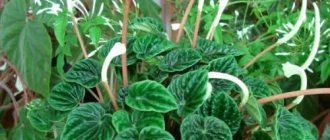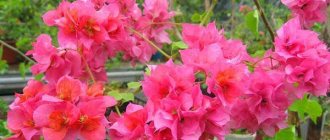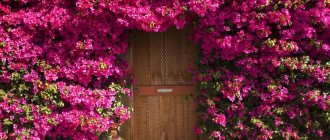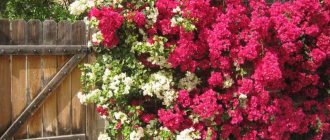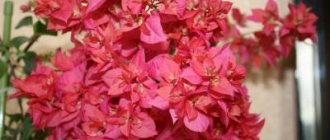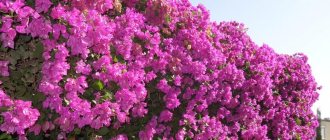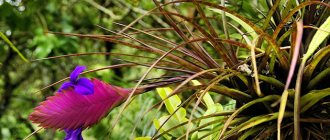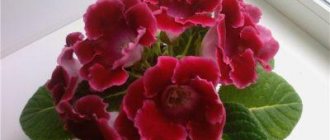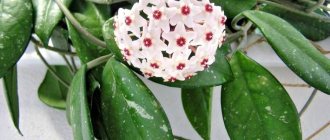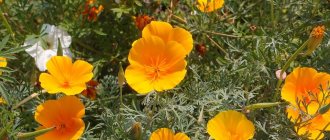Climatic conditions for growing Bougainvillea outdoors
Growing Bougainvillea garden in open ground is possible only in countries with a warm tropical climate. It does not tolerate cold and even when the air temperature drops below +5 °C it begins to get sick, and at 0 °C it can die. In Russia, climatic conditions suitable for this exotic are found only in Crimea in the southernmost regions of the peninsula. In other regions of our country, pot cultivation of heat-loving exotics is used and taken outside during the warm season.
With this method of care and maintenance, plants growing in a house or greenhouse in tubs or large pots are wintered indoors or in protected ground with a controlled climate. In late spring or early summer, when the threat of frost has passed, they are moved to fresh air and left in the garden as long as the weather is warm. Sometimes the tubs are buried, creating the illusion that the potted tree or shrub is growing directly from the ground. For example, Bougainvillea is cultivated in the Moscow region, in the southern Urals and some other regions of our country.
When taking a plant outside, you need to install the tub once; you cannot even turn it, changing the direction of the branches. Otherwise, the Bougainvillea will stop blooming and shed its leaves.
Description of the plant
This exotic beauty is difficult to confuse with other representatives. It is distinguished by its unusually lush appearance and beautiful bracts, which are often mistaken for the main flowers.
The leaves are oval in shape, with a pointed end. Their color is bright green, and on the reverse side, the leaf is much lighter. The main flowers are small in size and pale yellow in color.
Know. These shrubs have become famous for their bracts, which are found in the shape of hearts, triangles, and sometimes round.
Due to the unusual bracts, bougainvillea received the name paper flower, since they look as if they were created from crumpled paper. Bracts decorate the bush for a very long time. As for primary colors, they fade and fade quickly.
It is also important that the exotic beauty, growing at home, blooms from May to November. Having once seen this gorgeous bush, every gardener admits that bougainvillea has won his heart forever.
Choosing a place and landing
In order for Bougainvillea to develop well and bloom profusely on the street or in the garden, it needs to be provided with conditions as close as possible to its usual habitat. Under natural conditions, the heat-loving beauty usually grows on sunny rocky slopes. Therefore, when choosing a location for it, the following factors should be taken into account:
- the planting area should be well lit, protected from the wind, and free from other trees and shrubs;
- the soil on the site should be well aerated, drained, dense, neutral or slightly alkaline.
If garden soil for Bougainvillea does not meet these criteria, you can buy it in a specialized store or mix it yourself, from equal proportions of peat, turf soil, sand and humus.
Bougainvillea is planted in open ground in the spring, when stable warm weather is established outside, by cuttings or bushes, in pre-prepared holes. Before planting a plant, you need to make sure that their depth is sufficient so that a drainage layer can be laid on the bottom. Soil mixed with humus is poured onto the drainage and a seedling is placed. The soil around it needs to be lightly compacted and then watered abundantly.
Species diversity
It does not differ in an extensive list:
- Naked bougainvillea (Bougainvillea glabra). This plant is five meters high and has bracts of various colors. They can be white, yellow, purple, pink or red. The spines of this variety are not large in size. Naked bougainvillea is easy to shape because pruning is not a problem for it. 1850 was the period when Jacques Denis Choise, a Swiss botanist, described Bougainvillea glabra. The plant can be found in dry areas of Brazil. It usually likes rocky hills if they have carbonate soil.
- Wonderful bougainvillea (Bougainvillea spectabilis). Fifteen meters in height are impressive indicators for a plant. Pink, red and purple bracts are large. With these parameters, something like a vine can wrap around the facades and walls of gazebos due to the flexibility of the shoots and a large number of thorns. The plant blooms from April to December. The homeland of the Wonderful (Beautiful) bougainvillea is the Brazilian tropical forests.
- Peruvian bougainvillea (Bougainvillea peruviana).
Humboldt, a naturalist from Germany, discovered this variety for gardeners in 1810. The climbing plant has yellow flowers framed by purple and pink round bracts. Peruvian bougainvillea has short thorns and thin, ovate leaves. Lateral shoots do not appear in this variety, so the variety is considered stable in terms of plant pruning. Colombia and Peru are home to Bougainvillea peruviana. Three species were subsequently cultivated, and breeders developed the following varieties: - Australian Gold. A shrub with double bracts changes over time. Their original color changes from bright orange to pink. On large oval sheets, in some cases, burgundy spots appear.
- California Gold. The plant is interesting because it often confuses the flowering time and “transfers” it to the winter. It has golden bracts at the ends, which is why it got its name. Over time, this golden patina disappears and turns into a beige shade.
- Double Lilarose. Flame-like bracts are the main characteristic of this spectacular variety. They will delight the eye of a lover of all things beautiful for a long time, if you don’t overdo it with watering.
- Double Red. This variety is valuable because its purple-crimson color does not lose its brightness throughout the entire flowering period.
- White Cascade. The bracts of this variety are beautiful and resemble ivory in tone. Some of them may have a pink border.
- Beggum Sikkander. We are talking about an indoor plant with light green leaves. The bracts have a double color. The most popular combination is a white core and a purple frame.
Features of caring for Bougainvillea in the garden
Bougainvillea is an exotic beauty, growing and caring for it in the open ground is quite a troublesome task. But if climatic conditions allow and the basic rules of its maintenance are followed, it will delight with bright, abundant flowering 9 months a year in seasonal cycles of 4 to 6 weeks.
In the first 2-3 years in open ground, Bougainvillea actively grows and accumulates green mass, but does not bloom. It reaches its maximum decorativeness at the age of 4-5 years.
Temperature
Bougainvillea loves warmth. Even in the favorable California climate, when grown outside, there is still a risk of freezing. Therefore, those who are planning to grow a southern beauty should take into account what the temperature necessary for its harmonious development should be. Its parameters are as follows:
- in summer, during flowering - +21-27 °C;
- in spring at the beginning of the growing season - above + 10 °C;
- The minimum temperature of the earth's coma is +5 °C.
If in winter the plants placed outside in pots and tubs for the summer are kept in warm conditions, the dormant period will not occur, but in the summer their flowering will be weak.
Watering
Water for irrigation is taken warm and settled. An important condition is maintaining water balance. It is recommended to water abundantly, but not excessively: the soil should not become waterlogged, but drying out of the top layer is also undesirable.
In summer, Bougainvillea is watered 2 times a week, in the morning. With the arrival of autumn and until the next flowering, the frequency of watering is reduced, making sure that the soil around the trunk does not become too dry. If the plant has lost its leaves, watering must be stopped completely.
In hot, dry weather, green leaves are sprayed with warm water, while care must be taken to ensure that the bracts remain dry. During prolonged rainfall, in order to prevent rotting of the root system, it is better to protect the bush from excess moisture.
Top dressing
From April to September, Bougainvillea has a period of active growth, and during this time the plant needs to be fed. Every spring it is recommended to add humus under the bushes. In addition, for young seedlings, once every two weeks it is recommended to apply a complex of mineral or special fertilizers for flowering plants. They are scattered around the bush, and then the ground is loosened.
Starting from the second year, fertilizing is applied once every two months. In this case, preference should be given to those that contain potassium, iron and phosphorus. But you should be careful with nitrogen fertilizers; they can provoke an increase in green mass to the detriment of flowers and bracts.
Nitrogen fertilizers include: ammonium nitrate, ammonium sulfate, potassium nitrate, urea, sodium nitrate, calcium nitrate.
Crown trimming
Pruning young and skeletal branches allows you to form a beautiful crown and promotes lush and abundant flowering. If this is not carried out, the number of young shoots decreases, and as a result, the decorativeness of the plant as a whole decreases. Bougainvillea pruning in open ground is carried out in 3 stages:
- in the fall, before the start of the dormant period, the branches that have grown over the summer are shortened by half;
- in the spring, before the start of the growing season, bushiness is caused: lignified branches are cut to 10-13 cm;
- During the growing season, a crown is formed: branches that violate the intended composition and weak growth are removed.
When pruning, be sure to leave 5-7 cm of the current year's shoot. Dormant buds on old shoots are very difficult to awaken, and new shoots may not form.
Proper pruning of Bougainvillea consists of the following steps:
- Step 1. Prepare the necessary tools and materials: gardening gloves, pruning shears, disinfectant (bleach or medical alcohol).
- Step 2. To prevent the plant from becoming infected with diseases, wipe the pruning shears with a disinfectant.
- Step 3: Begin pruning by removing diseased, damaged or dead branches.
- Step 4. Before you start pruning healthy parts, re-disinfect the pruning shears with bleach or alcohol.
- Step 5. Remove branches that you think are unnecessary and those that were damaged during the pruning process.
- Step 6: Step back a few steps, carefully inspect the plant, and continue pruning until you achieve the desired shape.
- Step 7. Remove all cut branches from the area.
- Step 8. To encourage fruit set, repeat pruning throughout the growing season every 4-6 weeks or as needed.
- Step 9. Between regular prunings, pinch - manually tear off the wilted tops of the inflorescences.
- Step 10. After trimming a large number of branches, feed the Bougainvillea with complex fertilizer.
Advice from experienced gardeners:
- To prevent flowering from becoming less abundant or stopping altogether, do not prune your Bougainvillea too low.
- Remember to regularly remove wilted flowers. Remaining on the bush, they delay the formation of new buds.
- When working with bougainvillea garden, do not forget to wear work gloves. Thick branches and sharp thorns can hurt your hands.
As you master pruning Bougainvillea, keep in mind that pinching can be done at any time of the year and as often as you want. The more often you prune faded blossoms, the more new flowers will form on the plant.
You can choose the shape of the crown at your discretion: leave it to grow as a vine, form it into a bush, or graft it onto a standard.
Liana-shaped crown
To support the vine and make it aesthetically pleasing, it is necessary to select a suitable support. You can shoot shoots along the walls of a gazebo or house, purchase a suitable support in a specialized store, or make it yourself, for example, from wire, willow twigs, or bamboo stems. The shape of the support can also be varied: arch, lattice, wigwam.
Bush formation
To form a bush of a certain shape, a wire fence is installed around it. Young shoots are directed along the fence and are fixed to it as they develop. After the base of the form has been formed and the shoot has outgrown the fence by a few centimeters, pruning is carried out. Only the upper, young, green shoots are subject to formation. Lignified branches need to be cut off completely, as they are not suitable for crown formation.
Formation of a standard form
This method of cultivation may take several years. The first step is to determine the future height of the trunk and the desired crown diameter. A support corresponding to these dimensions is placed next to the plant. The cutting is carefully pulled to it and fixed. As soon as the cutting outgrows the support by a couple of centimeters, you need to pinch the growth point and then remove all the shoots from the standard stem. You can leave only a few upper branches, which will be the basis of the future crown. Pruning is carried out only for young shoots. When the crown is finally formed, remove all shoots that violate its boundaries. Over time, the trunk will become more powerful and will begin to resemble a tree trunk.
Bougainvillea pests
Photo: pixabay.com
Insects can be brought into the house on purchased flowers. As a rule, these are typical harmful insects and measures to combat them are traditional. During treatment with chemicals, it is better to cover bougainvillea with plastic bags.
Aphid. This little thing is easy to detect with the naked eye, most often on the back of the leaves. She sucks the juices out of them, covering them with spots.
Plants are treated against insects with Actellik (3) (15 - 20 drops per 1 liter of water). Mealybug. Also a familiar “beast”. It is also called the hairy louse, felt louse (4). The white hairy crumbs can quickly turn a bougainvillea into a herbarium, but first they will coat the leaves with sticky honeydew or sooty fungus.
If there are a lot of scale insects, they resort to the help of Karbofos, Aktara, Aktellika or Fitoverma (3), treating the plants at least 2 - 3 times.
But this is an extreme measure, if the plant is not too affected, the leaves are wiped with a swab moistened with a soap solution (1 teaspoon of shavings per 1 liter of boiling water) once a week until the enemy is completely destroyed. After each treatment, wash with a warm shower.
Bougainvillea is also sprayed with emulsion (1 liter of warm water and 2 tablespoons of olive oil).
Reproduction of garden Bougainvillea
Bougainvillea garden is propagated in three ways: layering, cuttings and seeds. Moreover, the most effective of them are the first two.
By layering
When propagating using layering, a young, low-lying shoot is selected. You need to make circular notches on it, bend it low to the ground and fix it in this position. With this method, regular and abundant watering of both the mother bush and the cuttings is recommended. You can separate the new plant from the mother plant immediately after rooting or next spring.
Cuttings
Cuttings from Bougainvillea garden are cut in late spring or early summer. You can take those that remain after formative pruning, but they must be lignified. The cut is made under the kidney. The shoots are cut into several pieces of 10-15 cm with 3-4 leaves, placed in settled water at room temperature for several hours, and then treated with a growth stimulator. After processing, the leaves, which should be located at the bottom of each cutting, are cut off. Each cutting is placed in a substrate of peat and sand, sunk into the ground up to the second internode, watered and covered with a jar or a mini-greenhouse is built. The room temperature must be maintained at 25 °C. Watering is no longer carried out, but the cuttings are ventilated and sprayed with water daily. A month later, when the roots have grown, it is planted in a permanent place.
Seeds
This is the most labor-intensive and time-consuming method. The seeds are found in pods inside dried bracts. They can only be collected from large, well-rooted plants. To obtain seedlings, seeds are sown in moist soil poured into a container from garden soil, peat and sand in a ratio of 2:1:1. A mini-greenhouse is best suited for germination. If it is not there, the soil is covered with film. From time to time, the substrate with seeds is slightly moistened. After the shoots appear and before they are picked, the film is opened for ventilation.
1.Seven secrets of success:
| 1. Growing temperature: summer - 18 - 24 ° C, winter - it is advisable to provide a cool dormant period at a temperature of 10 - 13 ° C. The plant should not be exposed to temperatures below 7 ° C. |
| 2. Lighting: Brightly lit location, bougainvillea should receive sunbath in the morning and evening daily. |
| 3. Watering and air humidity: water with warm water during spring and summer in such a way as to dry out a 2-3 cm thick layer of soil between them. In autumn, watering is reduced and in winter it protects the soil from completely drying out. Air humidity is increased only to prevent invasions of harmful insects. |
| 4. Pruning: formative pruning in the fall to maintain a beautiful shape, sanitary pruning as necessary. |
| 5. Soil: organic-based, neutral or slightly acidic, nutritious substrate, easily permeable to moisture and air. |
| 6. Feeding: every 2 weeks, bougainvillea is fed with liquid mineral fertilizers in half concentration during the warm season. In the fall, fertilizing is reduced and in winter the plants are put into a dormant period, denying the flower the application of fertilizers. |
| 7. Reproduction: by half-ripe stem cuttings, air layering, grafting, seed method. |
Botanical name: Bougainvillea.
Bougainvillea domestica - family
Origin, where it grows. Brazil.
Description. Bougainvillea is a fast-growing tropical, semi-evergreen vine or shrub from South America with brightly colored bracts surrounding small tubular terminal flowers from early spring to late summer.
Plants have flexible, climbing shoots. Plant stems bear thorns.
The leaves are oblong - lanceolate or ovate, with pubescence, arranged alternately.
The flowering of bougainvillea is not of particular interest - the yellowish flowers do not differ in brightness or size, the eye is attracted by the bright bracts. Large clusters of pink, red, orange or purple bracts are produced primarily in the summer months. Flowering plants are almost completely covered with bright clusters of buds.
When grown indoors, the plant does not produce fruit.
In modern floriculture, there are variegated or variegated plants with white specks on the leaf blades.
Bougainvillea flower - height. Up to 4.5 m without trimming. Can be grown as a bonsai - the height of the plant is regulated by pruning.
The flower develops quickly and in just one season it can add up to 2 - 3 m in height.
Caring for bougainvillea outdoors in winter
As already mentioned, growing Bougainvillea in open ground is possible only in areas where the temperature of the earthen coma enveloping its roots does not fall below + 5 °C. In Russia, these are the southernmost regions of the Crimean peninsula. But even here there is no guarantee that Bougainvillea will not freeze in winter. Therefore, for the winter (in the coldest months), it is advisable to cover it with special material and cover the ground around the trunk with spruce branches.
With tub crops grown in colder regions, for example Bougainvillea in the Moscow region, everything is simple - so that the heat-loving beauty does not freeze, the tub or pot with it needs to be moved to a house or greenhouse at the end of August or early September.
Otherwise, caring for Bougainvillea in winter is not too difficult. Before the onset of cold weather, it is recommended to shorten the shoots by half. Watering in winter is not interrupted, but is carried out much less frequently than in summer, just so that the earthen ball does not dry out.
Lighting
The ability to choose the right place with optimal natural light, and, if necessary, adjust the value with artificial light is a task equivalent to balancing the temperature regime for indoor plants. It happens that those who “tamed a pet”, being irresponsible about the issue of light, simply ruined the plant, without waiting for the dream of the charm of a flowering tree to come true.
For the intensive development of bougainvillea, it is extremely important to provide bright light. It is one of the few plant species whose life directly depends on the amount of sunlight. For this purpose, choose the sunniest place for the flower, ideally a south-facing window sill. You should know that during daylight hours, bougainvillea should receive plenty of sunbathing for at least 5 hours. You should not be afraid of the scorching rays of the midday sun and getting burns. The South American ultraviolet lover will fully grow, develop and amaze the imagination of mankind with the brightness of the colors of the bracts only when she is given plenty of light. Poor lighting will inevitably lead to stretched stems, faded green foliage and a cessation of flowering.
However, there are nuances in the topic of bougainvillea lighting, depending on the time of year and periods of flower activity. It will need the maximum amount of light from the very first month of spring until October, that is, for the flowering period. During its well-deserved rest, during the winter dormancy period, the plant will feel comfortable in a place shaded from sunlight.
Air humidity
Like any subtropical crop, bougainvillea prefers high air humidity, even when in a Moscow apartment. Regular spraying of the plant with soft water that has stood for at least 2 hours will help create conditions close to tropical ones. Therefore, take the trouble to arm yourself with a spray gun.
During flowering, the air is humidified selectively in the area of the bush, preventing droplets from falling on the surface of the bracts. During the dormant period, feel free to irrigate the inner and outer surfaces of the leaves for the benefit of the entire plant.
To create optimal air humidity, you can use other well-known methods, for example, an electric humidifier. It will be effective to place a pot with a flower on a tray with moistened pebbles or expanded clay. You can place a vessel under the bush, for example, a glass brazier filled with water. Remember that the larger the water surface area, the higher the humidity level can be achieved.
All efforts to ensure comfort will benefit your pet and will turn out to be a treat for the eyes.
Transfer
With the arrival of spring, the dormant stage comes to an end and the bush begins active growth. The green mass, roots and shoots grow intensively. At this very moment in early spring, it is recommended to replant bougainvillea.
Young “pets” grow rapidly. In close to ideal greenhouse conditions, the height of the bush increases to 3 meters in one year. It is noteworthy that in a spacious container your flower will grow long stems and branches. A cramped pot will provoke extremely lush flowering, while the height of the bush will change only slightly. At a young age, the plant is replanted annually. Thus, the proper level of nutritional value of the soil mixture is achieved.
An adult bougainvillea can hardly tolerate the worries associated with the transplantation procedure. It can get sick, lose its leaves and stop flowering altogether. Therefore, mature plants are replanted every 3-4 years. In this case, they prefer the method of transferring it into a container with a large diameter and try to avoid injury to the root system. It is important to check whether the root collar is buried in order to correct the situation in time.
The free gap that appears between the earthen lump and the walls of the pot is filled with new soil and only slightly pressed down, without compacting, but also without leaving voids. The bush is watered and placed for several days of rest in a shaded corner. After the roots have settled into their new home, the flower is returned to its usual place.
The weighty lashes of an adult plant along with flowers are quite heavy and need support. Bamboo or other strong supports are installed in the pot. To properly form a young bush, you will also need to install a bracket in the pot or stick a special ladder into the substrate.
Compliance with the rules for using the following three attributes of transplantation will allow you to carry out the process safely, and the flower will easily survive stress and quickly adapt.
- Pot. It is better to choose a deep pot that allows roots to develop. Mistakenly, some beginners prefer choosing an overly large flowerpot. According to the rules, the diameter of each subsequent container should exceed the previous one by the thickness of two fingers, about 3 cm. Too large a volume provokes stagnation of moisture and rotting of the roots, which is difficult to combat. When replanting into the previous container, wash it thoroughly and disinfect it. Shorten the roots enough to make them more comfortable.
- Drainage. Under natural conditions, bougainvillea grows on rocky soils. At the bottom of the pot, it will definitely need a generous layer of drainage: expanded clay, crushed stone or broken red brick.
- Priming. For a luxurious Brazilian beauty, prefer a store-bought special substrate. If this is not possible, you can make your own mixture of sand, compost, turf and leaf soil in a ratio of 1:1:2:2.
Top dressing
Feeding bougainvillea is a must! Especially during the activation of growth and flowering, the plant needs to receive nutrients at least once every 2 weeks. Flower growers with experience of communicating with the “Brazilian girlfriend” recommend using fertilizers of organic and mineral origin, specifically designed for ornamental flowering plants. During the dormant period, feeding should be stopped.
When choosing fertilizers, pay special attention to the fact that nitrogen compounds stimulate growth, while potassium and phosphate compounds stimulate flowering.
